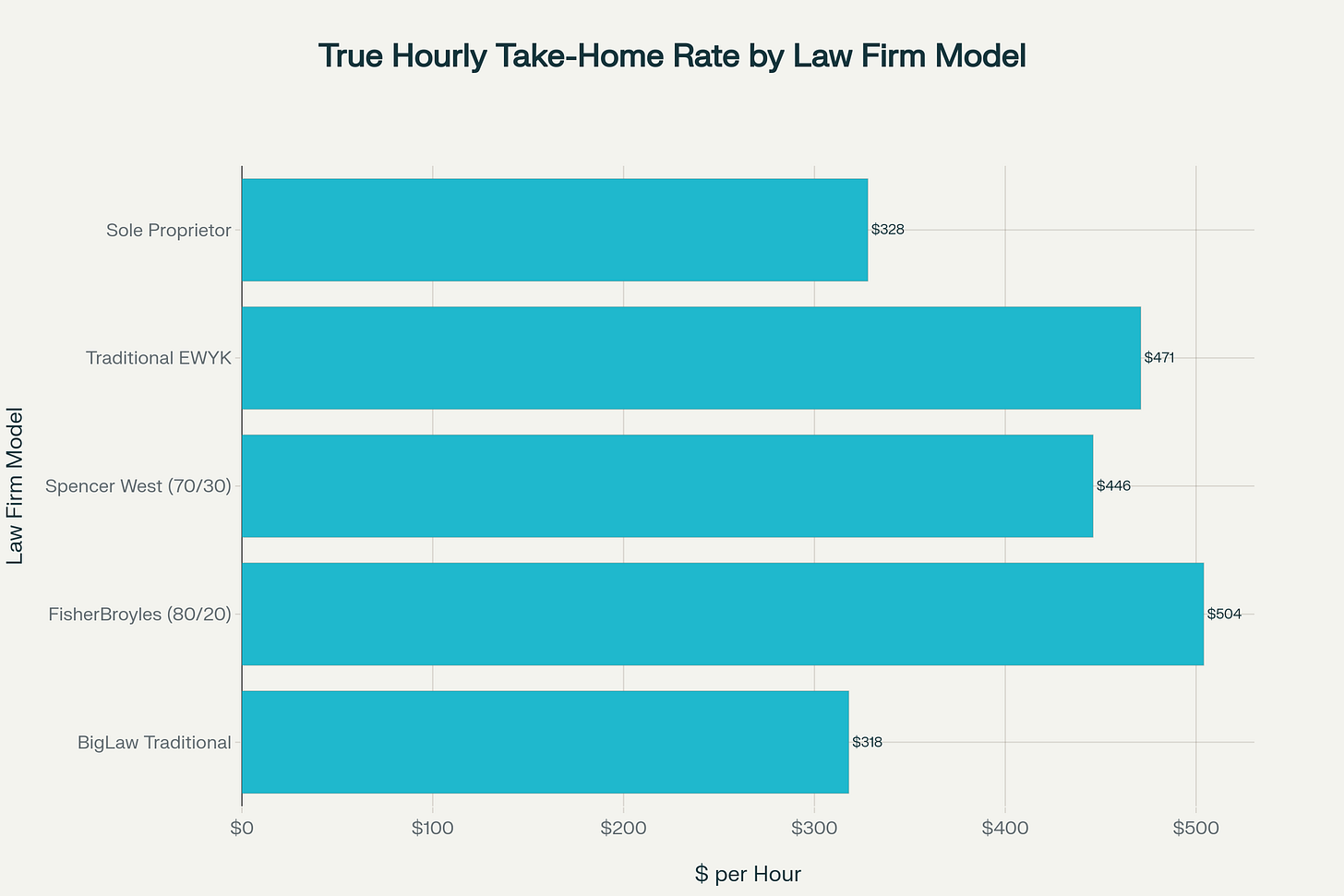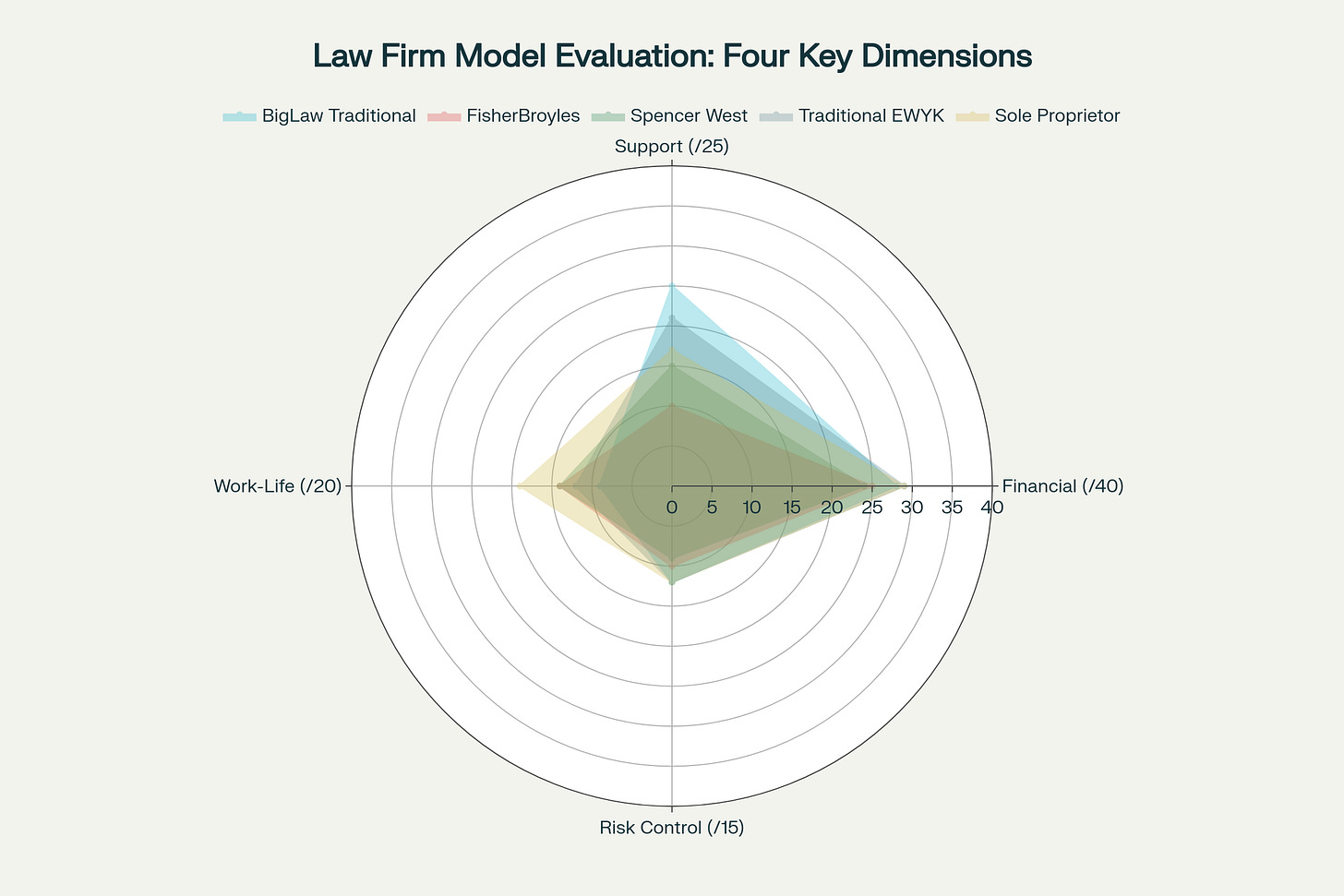Empowering legal professionals
Make us your partner, to help you gain the competitive advantage you seek.

My Analysis of Distributed Law Firms, Eat-What-You-Kill Models, and Sole Practice Options.
The pitch sounds irresistible:
“Keep up to 80% of what you bill!”
But before I go any further, I want to point out that although I have focussed specifically on two international law firms for this article (Fisher Broyles and Spencer West) there are many law firms paying in similar ways, across the world, and I wish there were time to research them all - but these two were used as there is more publicly available information on them than many of their competitors.
Using a mix of research, fact and my personal opinion, any positive or negative comments in this piece are purely my humble opinion - I am sure the firms are stacked full of very nice people who are great professionals - and for the right lawyers, they would be a good home.
But my job, and my purpose, is to help Africa-based Lawyers make the right career and remuneration choices, as best I can - using my 23 years of global legal partner recruitment to advise.
Law Services companies like Fisher Broyles and Spencer West have built their successful businesses and recruitment strategies around the compelling promise of big splits, luring senior lawyers away from traditional partnerships (or sometimes, out of unemployment or sole proprietorship) with the allure of dramatically higher compensation.
But behind the marketing, and smiley demeanour of a friendly Managing Partner, sometimes lies a harsh reality that distributed law firms may or may not omit:
When you account for hidden costs, administrative burden, and lost leverage opportunities, that “70-80%” can sometimes, quickly, become something less attractive.
As a senior lawyer evaluating partnership opportunities, you deserve more than marketing slogans.
You deserve hard numbers, critical analysis, and a framework to evaluate what you’ll actually take home after accounting for all costs, not just the percentage that appears on the firm’s recruitment materials.
And that’s what I am aiming to do here.
(Per AI) A distributed law firm is a legal practice where lawyers and staff work remotely or from flexible, decentralised locations like home offices or smaller satellite offices, rather than a single, large central office. These firms leverage technology to connect lawyers who may not be in the same physical space, allowing them to collaborate, serve clients, and manage operations efficiently
Fisher Broyles has marketed itself in the past as offering partners up to 80% of their collections, positioning this as revolutionary compared to traditional BigLaw where partners typically see 33-35% of originations.
The firm has grown to AmLaw 200 status by recruiting from BigLaw with this compelling value proposition.
What is promoted: Keep 80% of everything you collect, work from anywhere, no billable hour quotas.
What they may not mention: That 20% the firm takes possibly covers only basic infrastructure, billing software, document management, malpractice insurance, and website.
Everything else? That’s on you.
Let’s examine a realistic scenario for a senior lawyer with $1.5 million in annual collections.
All figures in USD and numbers will vary from city to city, numbers are rounded up or down for ease.
The Reality Check (possible):
Subtotal You Might Receive: $1,200,000
But now add what YOU could pay:
(Possible) Total Hidden Costs: -$60,000
Lost Opportunity Costs:
Total Potential Opportunity Cost: -$350,000
Actual Net Take-Home under this fictitious example: $790,000
Most importantly, that would be roughly 53% of collections, not 80%.
Making your effective hourly rate? Circa $395/hour and that’s after working potentially 2,000+ hours including the 400 hours you spend on administrative tasks that you would have been used to delegating.

In my opinion Spencer West markets itself very well, skill-fully utilising LinkedIn and has often positioned itself in the past as more collaborative than others offering partners typically 70-80% of billings with good support infrastructure.
They appear to have been very successful, and have grown to over 400 partners globally by emphasising their community approach to the distributed model.
The Reality Using Our Example, Should Be:
Subtotal You Could Receive: $1,050,000
Possible Costs To Consider:
Possible Costs: -$45,000
Lost Opportunities:
Opportunity Cost: -$275,000
Actual Net Take-Home Under This Example: $730,000 (49% of collections, not 70%)
Let’s examine what you could get at a traditional BigLaw partnership:
For a $1.5M book of business:
Your Take Home: $675,000 (typically 45% including leverage)
But here’s what the firm could be paying for:
Total Support Value: ~$247,000
Plus associate leverage: You can delegate work to associates, expanding your capacity to serve more clients without personally doing the work. This could generate an additional $150,000-300,000 in value depending on your leverage ratio.
Your effective hourly rate: $385/hour on 1,750 actual working hours (not 2,300 like our research shows for FB).
The BigLaw model suddenly doesn’t look so bad when you account for everything you’re receiving in exchange for that higher percentage the firm retains.

Traditional firms with eat-what-you-kill (EWYK) compensation models offer a middle ground.
These firms compensate partners based on their individual production while still providing firm infrastructure.
Typical EWYK Structure:
The advantage: You get credit for what you produce without the administrative burden of doing everything yourself. The disadvantage: You’re often competing with partners rather than collaborating, which can create toxic firm culture.
The EWYK model works best for lawyers with established books who want individual recognition but don’t want to run their own shop.

When we analyse the possible take-home after all costs and opportunity losses:

Key Insight: The distributed firms’ marketed percentages bear little resemblance to what you actually keep.
So it could be that Fisher Broyles’s “80%” becomes 53% after hidden costs. Spencer West’s “70%” could become 49%.
Just keep that in mind, and do your numbers carefully.
Traditional firms count billable hours.
Distributed firms count them too - but sometimes ignore the 300-500 additional hours you’ll spend on:
According to reports, Fisher Broyles partners work an estimated 2,200-2,300 total hours annually if you include this un-billed administrative work.
BigLaw partners typically work 1,850-1,900 hours total because they have support staff handling most non-legal work.
You’re not just trading a higher percentage for lower support, you’re trading it for significantly more total work hours.

What BigLaw Provides (That Distributed Firms Sometimes Don’t):
Administrative Infrastructure:
Dedicated secretary and admin, Paralegal support ($65K value), Document processing teams, Conflicts checking and New business intake.
Marketing & Business Development:
Marketing department creating materials, Pitch book preparation, Event planning and hosting, Social media management and personal Brand building.
Technology:
Enterprise-grade systems, 24/7 IT support, Data security and compliance, Client portals, Matter management systems and AI platform access.
Professional Development:
CLE planning and payment, Coaching and mentoring, Leadership training and Practice group collaboration.
Total Value of BigLaw Support: $200,000-300,000 annually
Here’s another factor distributed firms downplay: you often must lower your rates to compete.
BigLaw partners at top firms bill $900-1,200/hour because of firm brand equity.
When you go distributed, clients expect a discount - after all, you don’t have BigLaw overhead.
Typical rate adjustments:
So you’re not just losing support infrastructure - you could possibly be losing 15-30% in rate power.
That $1.5M book at BigLaw might become $1.2M at a distributed firm simply due to rate compression.

To objectively evaluate opportunities, use this 100-point framework:
Financial Metrics (40 points)
Practice Support (25 points)
Work-Life Balance (20 points)
Risk & Control (15 points)
How Each Model Scores using our method:
EXAMPLE

Before joining an FB or a SW, my suggestion is to look for answers to these questions:
And look at the profiles of the lawyers in your local office…evaluate their backgrounds. Are they the type of lawyer that is going to attract good clients?
This question alone, would shape my approach if I were you. I wouldn’t want to work with lawyers that don’t advance my brand.
Whilst some of the examples I have painted above could possibly be accused of demonstrating how the distributed law firm model can fail senior lawyers through inadequate support and possible hidden costs, Thomson Wilks (TW) in South Africa proves it’s possible to deliver genuine value in a decentralised structure.
Over the past 23 years of recruiting for law firms, in 70 cities, I can smell BS a mile off and I can see when a firm is telling the truth - my interactions with TW have been incredibly positive and I wanted to highlight them because I believe they could be a great home for a senior Lawyer in South Africa.
Founded in 1995 and operating across Johannesburg, Durban, and Cape Town, TW pioneered the dispersed operating model over a decade ago - long before COVID-19 made remote work trendy.
What distinguishes them from its international counterparts isn’t just their 75/25 split; it’s the formidable centralised infrastructure that backs up every consultant attorney.
Real Infrastructure, Not Just Marketing:
Unlike others, Thomson Wilks provides consultant attorneys with:
This isn’t a billing platform masquerading as a law firm - it’s a genuine practice infrastructure that allows senior lawyers to focus on legal work rather than administration.
The 75/25 Split That Actually Works:
Thomson Wilks consultant attorneys keep 75% of their billings.
At first glance, this appears less attractive than the other models mentioned. But remember our earlier analysis: those percentages are illusory once you account for hidden costs.
Using the same example as above, the Thomson Wilks Check:
You Should Receive: $1,125,000
What You DON’T Pay For:
Total Support Value: $118,000+
Possible Costs:
Total Hidden Costs: -$48,000
Possible Net Take-Home: $1,077,000 (72% of collections)
Compare this to Fisher Broyles’s possible 53% or Spencer West’s potential 49%, and Thomson Wilks delivers 35-45% more true take-home than its international competitors while requiring significantly fewer working hours.
In April 2021, Thomson Wilks formalised an exclusive alliance with DWF Group, a global provider of integrated legal and business services.
After deep discussions with TW leadership, we can see how incredible the DWF relationship really is.
DWF is a publicly listed international firm with offices across Europe, Asia, the Middle East, and North America, handling some of the world’s most sophisticated legal matters.
This partnership gives Thomson Wilks consultant attorneys genuine international capability backed by a sophisticated global platform.
What the DWF Alliance Delivers:
Cross-Border Capability: Thomson Wilks attorneys can seamlessly collaborate on international transactions, accessing DWF’s resources in London, Paris, Dubai, Singapore, and beyond. This isn’t a loose referral network, it’s an exclusive partnership enabling integrated service delivery.
Sector Expertise: DWF’s specialisation in insurance, litigation, corporate M&A, real estate, and financial services complements Thomson Wilks’s strong commercial litigation and corporate practice. South African lawyers can work on sophisticated cross-border matters without leaving the Thomson Wilks platform.
Brand Enhancement: Associating with a London Stock Exchange-listed international firm elevates Thomson Wilks’s brand equity. Unlike distributed platforms where you’re essentially practicing under your own name, Thomson Wilks lawyers benefit from the reputational capital of both firms.
Integrated Legal Management: DWF’s approach combines legal advisory, managed services (Mindcrest), and connected services.
This means Thomson Wilks can offer clients comprehensive solutions beyond traditional legal advice - something solo practitioners and platform-based distributed firms simply cannot match.
It’s a bit unfair to match one against the other, because each could be a good home for different people - but hey, its a bit of fun and its my newsletter - so I can say what I want!
For senior lawyers evaluating distributed options, particularly those with South African connections or African market exposure, Thomson Wilks is, in my opinion, the far superior choice.
I am happy to be proven wrong - but I think I know what I am talking about.
Obviously this is based on our research, GRM is always happy to stand corrected.
But the shear quality of the SA based MP is no contest, the position in the market, the client base, even DWF in London is arguably a stronger connection than SW’s London office - there are many pluses in the TW column if one was choosing between the two.
The Thomson Wilks Model in Action:
This track record matters enormously when evaluating whether a distributed model is sustainable.
For lawyers focused on African markets, Thomson Wilks offers unique advantages.
They’ve established a specialised China Law Department to serve Chinese companies investing in South Africa and throughout Africa.
They have offices in Johannesburg (financial centre), Cape Town (legislative capital), and Durban (port city and KwaZulu-Natal commerce).
Through the DWF connection, Thomson Wilks attorneys can access DWF’s thriving Africa Desk, which handles insurance, property, energy, construction, and financial matters across both North and Sub-Saharan Africa.
DWF’s team includes French, Portuguese, and Arabic native speakers with 20+ years of Africa experience.
If you’re a senior lawyer considering a distributed model, Thomson Wilks demonstrates what the model should look like: generous compensation (75%) backed by genuine infrastructure rather than hollow promises (80%) backed by billing software.
The firm succeeds because it invests the 25% it retains into building real support systems that multiply attorney productivity and quality of life.
They prove that a decentralised practice model can work, but only when supported by a “formidable centralised infrastructure” rather than a minimalist platform approach.
For lawyers with South African connections, African market exposure, or those seeking international work through the DWF network, Thomson Wilks should be the first call.
The math is clear, the infrastructure is real, and the track record speaks for itself.
Fisher Broyles, Spencer West and others (Taylor Wessing being another) aren’t bad options for senior fee earners. “Horses for Courses” as we used to say.
An 80/20 split sounds revolutionary until you realise you could be paying for everything!! For most senior lawyers with books under $2 million, the math simply doesn’t work out better than traditional partnership when you account for all factors.
Firms like Thomson Wilks prove that distributed models can work - when backed by genuine infrastructure rather than marketing slogans.
The real question isn’t what percentage they promise - it’s what you actually take home after working how many hours with what level of support.
And by that measure, traditional partnerships and properly-structured distributed firms like Thomson Wilks often deliver far more value than platform-based distributed firms charging 20-30% for basic infrastructure.
Don’t be seduced by percentages or a smile. Do the math. Count the hours. Add up the hidden costs. Evaluate the infrastructure.
Then make your decision based on reality, not marketing.
If you want to talk about your options, contact me:
Rob Green on rob@thegrmgroup.com
For more please go to robgreen.substack.com